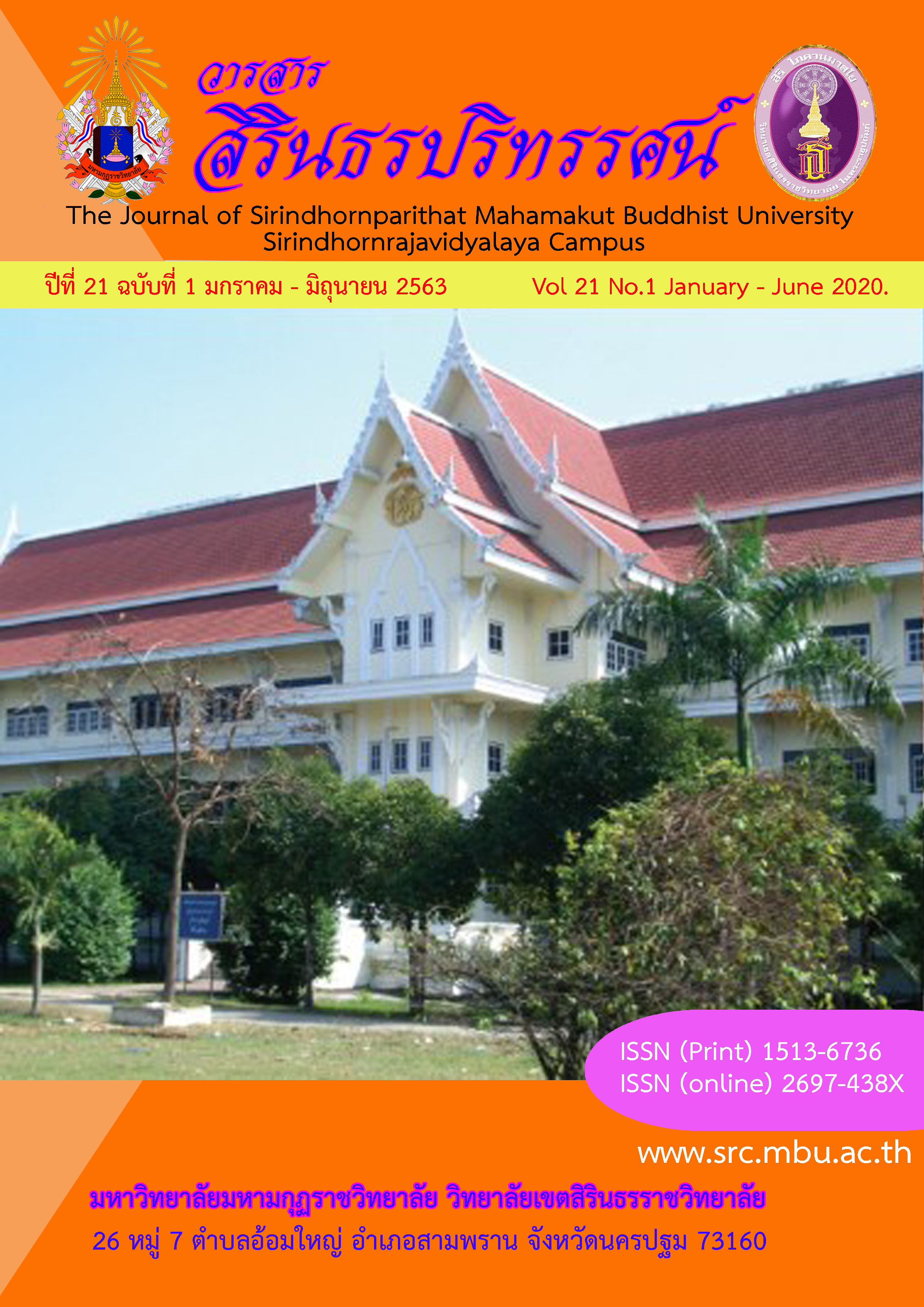Development of a Design Thinking Curriculum for Promoting Innovation Competencies of Nursing Students, Boromarajonani College of Nursing, Ratchaburi
Keywords:
Curriculum, Design Thinking, Innovation Competency, Nursing StudentAbstract
This research and development study aimed to develop a design thinking curriculum for promoting innovation competencies of nursing students, Boromarajonani College of Nursing, Ratchaburi, as well as to prove the curriculum and effectiveness. The methodology was divided into 4 phases, comprising basic data analysis, development of the curriculum, utilizing curriculum, and in phase IV; evaluation and improvement of the curriculum. The samples were 72 year 3 nursing students, and 18 nursing instructors. The research instruments included questionnaire of nursing students’ innovation competencies and opinion on using curriculum. Mean, standard deviation, paired t-test, and content analysis were undertaken to analyse data. The results showed that the instructional curriculum was demonstrated in 9 components: 1) background, 2) philosophy, 3) objective, 4) outcome, 5) structure, 6) lesson composed of 4 main topics: inspiration and passion building, team building and collaboration, design thinking process, and presentation and sharing in 45 hours, 7) learning process, 8) resource and media, and, 9) measurement and evaluation. The innovation competencies of nursing students’ post-curriculum mean score assessed by students and instructors were significantly higher than their pre-curriculum score at the p < 0.01 level.
References
กระทรวงศึกษาธิการ. (2561). ประกาศกระทรวงศึกษาธิการ เรื่องมาตรฐานสถาบันอุดมศึกษา พ.ศ. 2561. สืบค้นจาก http://www.ratchakitcha.soc.go.th/DATA/PDF/2561/E/199/T19.PDF
จุรีวรรณจันพลา. (2559). การเสริมสร้างภาวะผู้นำเชิงนวัตกรรมของผู้ประกอบการในธุรกิจแปรรูปอาหาร. วารสารเทคโนโลยีภาคใต้, 9(1), 53-59.
ทิศนา แขมมณี. (2554). รูปแบบการเรียนการสอนทางเลือกที่หลากหลาย. (พิมพ์ครั้งที่ 7) .กรุงเทพฯ: สํานักพิมพ์แห่งจุฬาลงกรณ์มหาวิทยาลัย.
นิวัฒน์ บุญสม และมาเรียม นิลพันธุ์. (2558). การพัฒนารูปแบบการเรียนการสอนตามแนวคิดของกระบวนการแก้ปัญหาอย่างสร้างสรรค์เพื่อส่งเสริมนวัตกรรมด้านสุขภาพของนักเรยนที่มีความสามารถพิเศษทางวิทยาศาสตร์. วารสารศิลปากรศึกษาศาสตร์วิจัย,7(1), 123-133.
ปรีดา ยังสุขสถาพร. (2561). นวัตกร 4 แบบ. สืบค้นจาก http://www.nia.or.th/innolinks/200806/ innovsystem.htm
พฤทธิ์ ศิริบรรณพิทักษ์. (2560). วิสัยทัศน์การพัฒนาประเทศไทย 4.0. เอกสารประกอบการดำเนินการพัฒนาตามหลักสูตรพัฒนาผู้อำนวยการสถานศึกษาวางแผนเสริมสร้างประเทศไทย 4.0 อัดสำเนา 2560.
พัชรา วงค์ตาผา และเนาวนิตย์ สงคราม. (2562). การพัฒนารูปแบบการเรียนรู้แบบผสมผสานด้วยการคิดเชิงออกแบบร่วมกับหลักการสอนแบบทริซเพื่อส่งเสริมการแก้ปัญหาทางวิศวกรรมของนิสิตนักศึกษาวิศวกรรมศาสตร์ระดับปริญญาบัณฑิต. วารสารวิศวกรรมศาสตร์ ราชมงคลธัญบุรี,17(2), 37–47.
ลักขณา สริวัฒน์. (2557). จิตวิทยาสำหรับครู. กรุงเทพฯ: โอ.เอส. พริ้นติ้งเฮ้าส์.
วิจารณ์ พานิช. (2555). วิถีสร้างการเรียนรู้เพื่อศิษย์ในศตวรรษที่ 21. กรุงเทพฯ: มูลนิธิสดศรี-สฤษดิ์วงศ์.
วิชัย วงษ์ใหญ่ และมารุต พัฒผล. (2563). Creative Team Learning ทีมการเรียนรู้สร้างสรรค์. กรุงเทพฯ: บัณฑิตวิทยาลัย มหาวิทยาลัยศรีนครินทรวิโรฒ.
วิชัย วงษ์ใหญ่ และมารุต พัฒผล. (2563). Internal Coaching: การโค้ชจากด้านใน. กรุงเทพฯ: บัณฑิตวิทยาลัย มหาวิทยาลัยศรีนครินทรวิโรฒ.
วิชัย วงษ์ใหญ่ และมารุต พัฒผล (2563). Passion - based learning ภาคปฏิบัติ. กรุงเทพฯ: บัณฑิตวิทยาลัย มหาวิทยาลัยศรีนครินทรวิโรฒ.
Chan, Z. C. (2013). A systematic review of creative thinking/creativity in nursing education. Nurse Education Today, 33(11), 1382-1387
Chell, E., & Athayde, R. (2009). The identification and measurement of innovative characteristics of young people.Kingston University. Retrieved from http://eprints.kingston.ac.uk/5985 /2/chell-E-5985. pdf.
Cusson, R. M., Meehan, C., Bourgault, A., & Kelley, T. (2019). Educating the next generation of nurses to be innovators and change agents. Journal of Professional Nursing, 36(2), 13-19.
Gibbs, G. (2001) Learning by doing: A guide to teaching and learning methods. Geography Discipline Network from https://books.google.co.th/books/about/ Learning_by_Doing. html?id=xVv4SAAACAAJ&redir_esc=y
Johns, C. (Ed.). (2017). Becoming a reflective practitioner (5th ed.). Oxford: John Wiley & Sons.
Kagan, S., & Kagan, S. (1994). Cooperative learning (Vol. 2). San Juan Capistrano, CA: Kagan Cooperative Learning.
Keinänen, M., Ursin, J., &Nissinen, K. (2018). How to measure students’ innovation competences in higher education: Evaluation of an assessment tool in authentic learning environments. Studies in Educational Evaluation, 58, 30-36. DOI: 10.1016/j. stueduc.2018.05.007
McClelland, D. C. (1961). The Achieving Society. Princeton: N. J. Van Nostrand.
Roberts, J. P., Fisher, T. R., Trowbridge, M. J., & Bent, C. (2016). A design thinking framework for healthcare management and innovation. In Healthcar, 4(1), 11-14).
Stoeber, J., Childs, J. H., Hayward, J. A., & Feast, A. R. (2011). Passion and motivation for studying: predicting academic engagement and burnout in university students. Educational Psychology, 31(4), 513-528.
Tantillo, M., Marconi, M. A., Rideout, K., Anson, E. A., &Reifenstein, K. A. (2017). Creating a nursing student center for academic and professional success. Journal of Nursing Education, 56(4), 235-239.
The Stanford d. school Bootcamp Bootleg (HPI). (2010). An Introduction to Design Thinking PROCESS GUIDE. Retrieved from https://dschool-old.stanford.edu/sandbox/groups/ designresources/wiki/36873/attachments/74b3d/ModeGuideBOOTCAM P2010L.pdf
Thrash, T. M., & Elliot, A. J. (2004). Inspiration: core characteristics, component processes, antecedents, and function. Journal of personality and social psychology, 87(6), 957-973.
Thrash, T. M., Maruskin, L. A., Cassidy, S. E., Fryer, J. W., & Ryan, R. M. (2010). Mediating between the muse and the masses: Inspiration and the actualization of creative ideas. Journal of personality and social psychology, 98(3), 469-487.
Trilling, B., &Fadel, C. (2009). 21st century skills: Learning for life in our times. CA: John Wiley & Sons.
Wartiovaara, M., Lahti, T., &Wincent, J. (2019). The role of inspiration in entrepreneurship: Theory and the future research agenda. Journal of Business Research, 101, 548-554.
Downloads
Published
Issue
Section
License
บทความที่ได้รับการตีพิมพ์เป็นลิขสิทธิ์ของ มหาวิทยาลัยมหามกุฏราชวิทยาลัย วิทยาเขตสิรินธรราชวิทยาลัย
ข้อความที่ปรากฏในบทความแต่ละเรื่องในวารสารวิชาการเล่มนี้เป็นความคิดเห็นส่วนตัวของผู้เขียนแต่ละท่านไม่เกี่ยวข้องกับหาวิทยาลัยมหามกุฏราชวิทยาลัย วิทยาเขตสิรินธรราชวิทยาลัย และคณาจารย์ท่านอื่นๆในมหาวิทยาลัยฯ แต่อย่างใด ความรับผิดชอบองค์ประกอบทั้งหมดของบทความแต่ละเรื่องเป็นของผู้เขียนแต่ละท่าน หากมีความผิดพลาดใดๆ ผู้เขียนแต่ละท่านจะรับผิดชอบบทความของตนเองแต่ผู้เดียว




